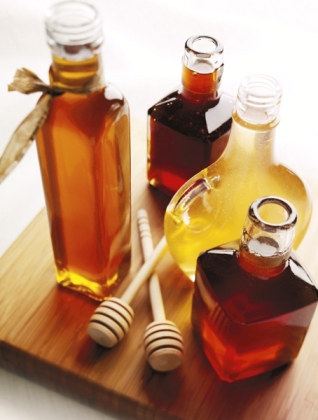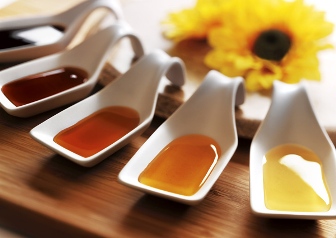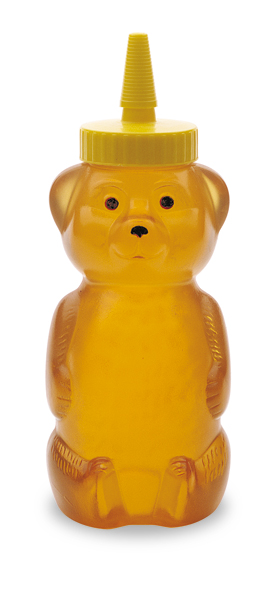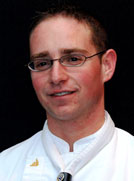Honey in the Classroom
31 May 2009By Mitch Stamm, CEPC, Johnson & Wales University
For baked goods, honey is more expensive than sucrose, but like butter, honey is prized for its taste, aroma and mouthfeel.
 |
Honey by the numbers
|
- In its life, a single bee is responsible for 1/12 of a teaspoon of honey.
- Bees have two sets of wings, one to fly and one to fan. The second set of wings fans more than 11,000 times per minute, evaporating water from the nectar.
- The internal temperature of the hive is 92° to 95°, another factor in water evaporation.
- A healthy hive produces 30 to 50 pounds of honey for consumption per year.
- Nearly 1 million hives are necessary to pollinate California’s almond crop covering almost 500,000 acres.

It is easy to capture the attention of students of all ages and levels with facts like these. Include a brief description of the “bee dance,” and all eyes and ears are focused. Scout bees signal distance, direction, landmarks, the abundance of nectar, wind speed, how much energy is required to reach the source and other factors influencing the foragers’ flight. And, bees are able to make on-the-fly adjustments to their flight plans.
Honey was one of the first sweeteners known to humans. Its use has been recorded for more than 10,000 years beginning with cave drawings and, later, written history. It was the primary sugar until the 1600s, when cane sugar became readily available. It is more expensive to use in baked goods than sucrose, but like butter, also expensive, it is prized for its taste, aroma and mouthfeel.
There are many reasons to include honey in baking formulations. Its sweetness and flavor are the most obvious. A natural invert sugar, honey is hygroscopic, attracting and retaining moisture, extending the shelf life of baked goods. Due to its acidity, with an average pH of 3.9, honey reacts well with baking soda to create carbon dioxide needed to leaven quick breads and other batters. As with other sweeteners, honey tenderizes baked goods by weakening gluten.
Owing to its properties as a reducing sugar, honey enhances the non-enzymatic browning known as the Maillard reaction, which gives the crusts of baked goods their distinctive color.
In yeasted breads, honey’s enzymes, acids, proteins and minerals stimulate fermentation, improving the final product with appropriate volume, bloom and crust color. A study of honey composition reveals that it contains fructose, glucose, saccharose, maltose and other sugars, in that order. The variety of sugars available for yeast metabolizing ensures robust, prolonged and balanced fermentation. When included in whole-wheat and rye bread formulations, honey increases and improves the intrinsic flavors of the grains while offsetting the bitterness often associated with them.
 Beyond the Classroom
Beyond the Classroom
The study of honey extends beyond its properties and characteristics in baked goods. It opens the classroom to a wider view, encompassing agriculture, economy, health, botany and nature, among others.
Wellness, local sourcing of ingredients and sustainability are topics that are generating a lot of discussion. Honey has long been used as a topical ointment for slight burns and shallow cuts. Scientists have confirmed its therapeutic use for sore throats as well as its antioxidant properties. Since ancient times, honey has been used as a topical ointment for minor cuts, burns and abrasions.
With the use of raw local honey, consumers can reduce their incidence of seasonal allergies while keeping their ecosystems and economies healthy. In recent years, beekeepers and farmers have been concerned with Colony Collapse Disorder, the inexplicable disappearance of bees. Media attention has waned, but the problem persists. The classroom is the first line of defense for keeping this precious food alive.
| Honey Cake | ||
| The accompanying recipe for a traditional honey cake combines honey with baking soda for effective chemical leavening and exploits the time-honored ritual of combining tea with honey. Buckwheat honey flavors and perfumes the bread with its dominant flavor, making honey the focal point while harmonizing beautifully with the rye flour. | ||
| Ingredient | U. S. Imperial Weight | Metric Weight |
| Whole egg | 1 lb. | .454 Kg. |
| Buckwheat honey | 3 lb. | 1.361 Kg. |
| Canola oil | .340 kg | .340 Kg. |
| Brewed Earl Grey Tea | 1 lb., 8 oz. | .684 Kg. |
| Zest, orange | 2 ea. | 2 ea. |
| Zest, lemon | 2 ea. | 2 ea. |
| Medium rye flour | 2 lb., 12 oz. | 1. 247 Kg. |
| Granulated sugar | 1 lb., 8 oz. | .684 Kg. |
| Baking soda | .5 oz. | .015 Kg. |
| Salt | .3 oz. | 010 Kg. |
| Cinnamon | .25 oz. | .0065 Kg. |
| Clove | .125 oz. | .00325 Kg. |
| Nutmeg | .125 oz. | .00325 Kg. |
| Golden raisins | 14 oz. | .400 Kg. |
|
Method:
|
||

Mitch Stamm, CEPC, is an associate instructor at Johnson & Wales University in Providence, R.I., where he teaches principles and techniques of bread making. An international medal winner, Stamm trained at Dunwoody Technical College, the National Baking Center, the French Pastry School, San Francisco Baking Institute, and l’École Lenôtre in Plasir, France. He is an active member of the Bread Bakers Guild of America and the American Culinary Federation.
